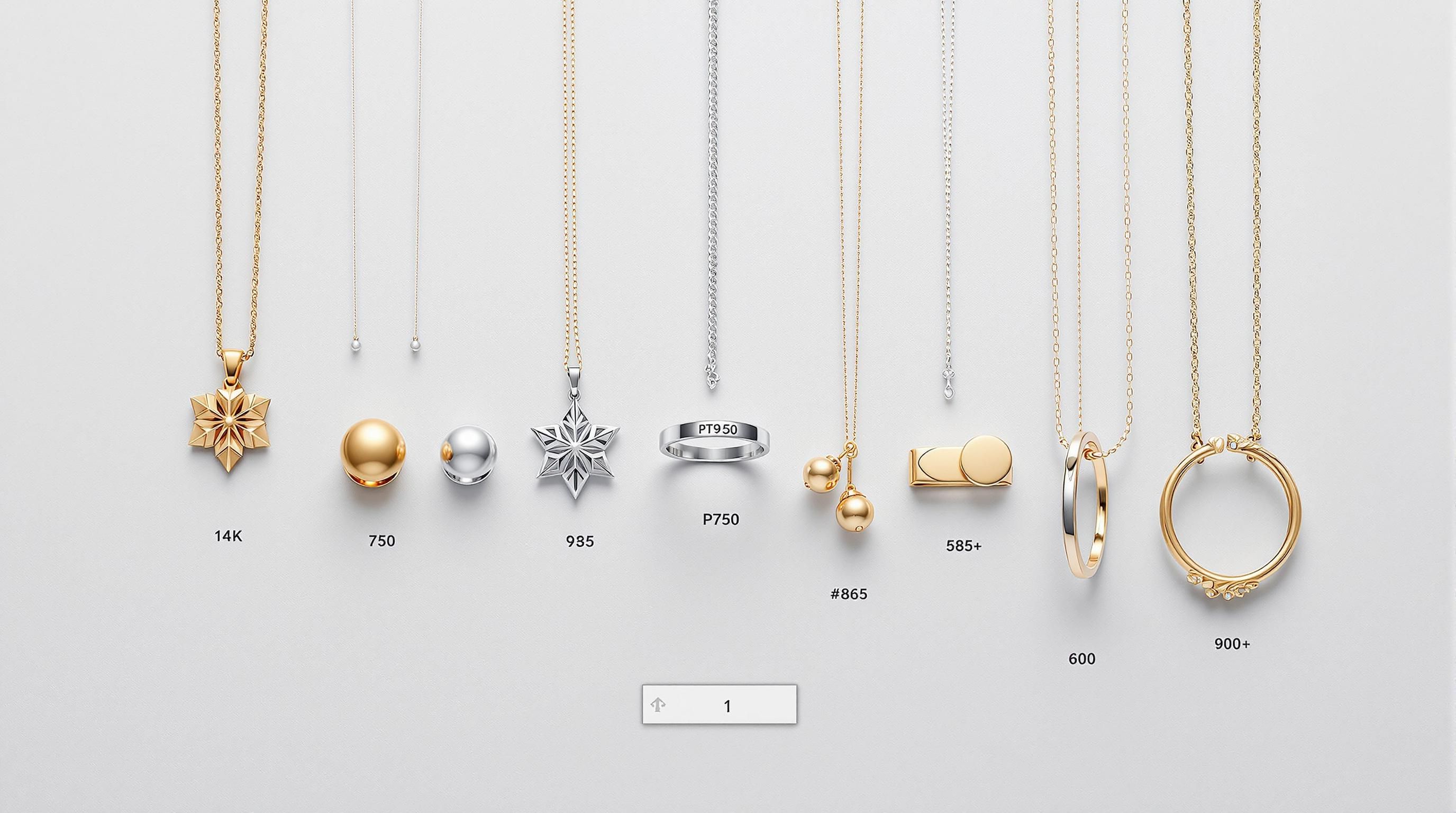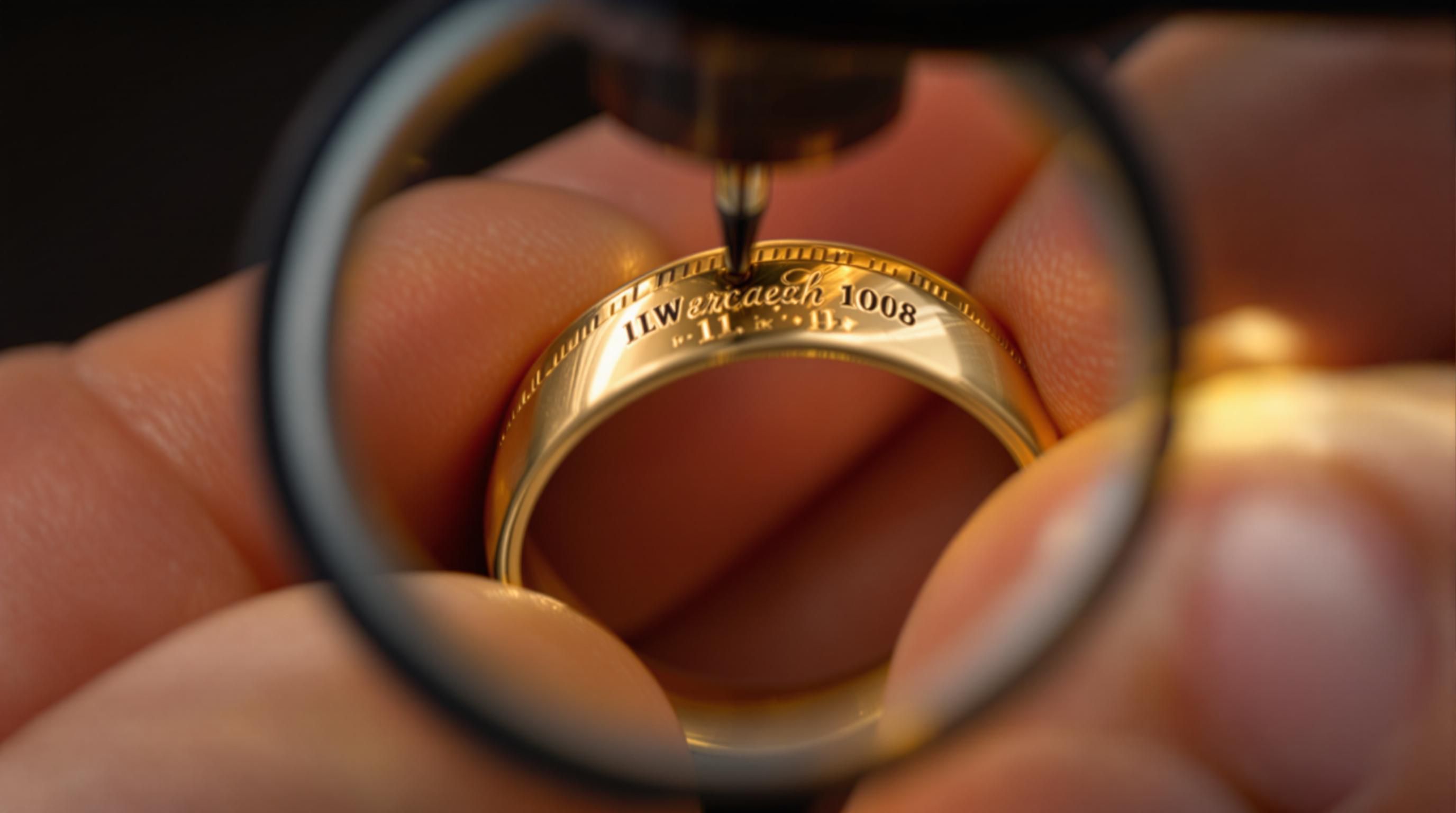Discovering a mysterious mark on your jewelry can feel like finding a hidden treasure map. These tiny stamps and symbols tell a valuable story about your piece’s origin, age, quality, and potential worth. Whether you’ve inherited family heirlooms, stumbled upon a vintage treasure, or simply want to assess your current collection, understanding jewelry markings is essential for determining authenticity and value.
In this comprehensive guide, we’ll walk you through the process of identifying and interpreting the various marks found on jewelry, from hallmarks and purity stamps to maker’s marks and special symbols. With the right knowledge, you’ll be able to uncover the secrets behind those tiny impressions and better understand the true value of your precious pieces.
The Importance of Jewelry Markings
Jewelry markings are more than just decorative elements—they’re crucial pieces of information that help authenticate and value your items. These markings typically fall into several categories:
- Metal purity marks - Indicate the quality and composition of the metal
- Maker’s marks - Identify the manufacturer or jewelry designer
- Country or city hallmarks - Reveal where the piece was made or assayed
- Date letters - Help determine when the piece was created
- Special symbols - Provide additional information about the piece
Understanding these markings can help you:
Why Jewelry Markings Matter
- Verify authenticity - Distinguish genuine pieces from counterfeits
- Determine value - Precious metal content significantly affects worth
- Identify origin - Connect your jewelry to specific countries, periods, or makers
- Learn history - Uncover the story and provenance of antique or vintage pieces
Jewelry without markings isn’t necessarily fake or worthless, but it can be more challenging to authenticate. Some antique pieces predate standardized marking systems, and certain types of jewelry (particularly delicate items) may not have space for visible markings.
Essential Tools for Examining Jewelry Markings
To properly examine and identify jewelry markings, you’ll need:
Jewelry Marking Identification Tool Kit
Essential items for examining jewelry markings
- Jeweler's loupe (10x magnification is standard)
- Good lighting source (natural light or a bright desk lamp)
- Clean, soft cloth for polishing
- Smartphone with camera for taking clear photos
- Ruler or calipers for measuring dimensions
- Hallmark reference guide or app
The most important tool is a quality jeweler’s loupe. These specialized magnifying glasses allow you to see tiny details that are invisible to the naked eye. When examining markings, try to find a well-lit area—natural light is ideal, but a bright desk lamp can work well too.
Once you’ve gathered your tools, carefully clean your jewelry with a soft cloth to remove any dirt or tarnish that might obscure the markings. Be gentle, especially with antique pieces, as harsh cleaning can damage delicate settings or patinas.
Gold Jewelry Markings
Gold jewelry markings are primarily designed to indicate purity—how much actual gold is in the alloy. Pure gold (24K) is too soft for most jewelry applications, so it’s typically mixed with other metals for durability.
Common Gold Purity Markings
Karat markings and their meaning on gold jewelry
</tbody>
</table>
In addition to these standard markings, you might find country-specific gold marks:
- GP - Gold Plated (thin layer of gold over base metal)
- GF - Gold Filled (thicker layer of gold mechanically bonded to base metal)
- RGP - Rolled Gold Plate (similar to gold filled)
- HGE - Heavy Gold Electroplate (electroplated gold layer)
A piece marked “18K” contains 75% pure gold, while the rest consists of other metals like silver, copper, or zinc that add strength and sometimes alter the gold’s color (creating variations like rose gold or white gold).
In some countries, particularly in Europe, gold purity is marked with a three-digit number representing parts per thousand. For example, “750” means 750 parts per 1000, or 75% gold—equivalent to 18K.
Silver Jewelry Markings
Silver jewelry also features markings that indicate purity, though the standards differ from gold. The most common silver markings include:
Common Silver Purity Markings
Silver standard markings and their meaning on jewelry
| Category | Price | Notes |
|---|---|---|
| **24K or 999** | 99.9% pure gold | Rare in jewelry due to softness |
| **22K, 916, or 917** | 91.6-91.7% gold | Common in Asian and Middle Eastern jewelry |
| **18K or 750** | 75% gold | High-quality jewelry, popular worldwide |
| **14K or 585** | 58.5% gold | Standard for U.S. fine jewelry |
| **10K or 417** | 41.7% gold | Minimum karat that can be legally sold as gold in the U.S. |
</tbody>
</table>
Silver jewelry may also feature country-specific marks:
- Lion Passant - British sterling silver standard
- Minerva Head - French silver hallmark
- Crown over number - Various European silver standards
- SP - Silver Plated (thin layer of silver over base metal)
- EPNS - Electroplated Nickel Silver (silver plating on nickel alloy)
In antique silver pieces, particularly those from Britain, you might encounter a series of hallmarks rather than a simple number. These can include:
- Standard mark - Indicates silver purity (e.g., lion passant for sterling)
- City mark - Shows which assay office tested the piece
- Date letter - Reveals the year of assay
- Maker’s mark - Identifies the silversmith or company
- Duty mark - Found on pieces when tax was paid (historical)
Platinum and Other Precious Metal Markings
While gold and silver are the most common precious metals in jewelry, platinum, palladium, and other metals have their own marking systems:
Platinum Markings:
- PLAT or PT - Indicates platinum content
- 950 or PT950 - 95% platinum (most common)
- 900 or PT900 - 90% platinum
- 850 or PT850 - 85% platinum
Palladium Markings:
- PALL or PD - Indicates palladium
- 950 or PD950 - 95% palladium
- 500 or PD500 - 50% palladium
In the United States, platinum jewelry must contain at least 95% pure platinum to be marked simply as “Platinum.” Items with lower platinum content must specify the percentage (e.g., “850 Platinum” or “85% Platinum”).
Evolution of Precious Metal Marking Systems
- 14th Century
First Hallmarking Laws
The earliest formal hallmarking systems began in France and England to protect consumers from fraudulent gold and silver. - 1300s
London Assay Office
Establishment of the London Assay Office, one of the oldest continuously operating hallmarking authorities. - 1700s
American Silversmith Marks
American silversmiths began marking their work consistently with maker’s marks rather than standardized hallmarks. - 1906
U.S. National Stamping Act
Legislation requiring accurate marking of gold and silver quality in the United States. - 1976
Vienna Convention
International hallmarking convention establishing consistent standards across participating countries. - 2000s
Laser Hallmarking
Introduction of laser technology for applying microscopic hallmarks to delicate jewelry.
Identifying Maker's Marks

Maker’s marks are often the most exciting marks to identify, as they connect your jewelry to specific designers or manufacturers. These can range from full names to initials, logos, or symbolic images.
Famous jewelry houses often have distinctive marks that can significantly increase a piece’s value:
- Tiffany & Co. - “TIFFANY & CO.” or “T & CO.”
- Cartier - Typically “Cartier” with a serial number
- David Yurman - “D.Y.” or “©D.Y.”
- Mikimoto - “M” in a circle or “MIKIMOTO”
- Pandora - “ALE” (founder’s initials) or “P”
- James Avery - “JA” or full signature
Identifying an unfamiliar maker’s mark typically requires research. Start by noting:
- The exact characters, symbols, or design
- The position of the mark on the piece
- Any additional marks nearby (hallmarks, date letters)
Popular resources for identifying maker’s marks include:
Maker's Mark Identification Resources
Antique Jewelry University
Comprehensive database of jewelry marks with historical context and detailed images.
Heritage Auctions Reference Guide
Extensive catalog of maker’s marks with examples from auction items.
Online Hallmark Encyclopedia
Searchable database of silver and gold hallmarks including maker’s marks.
Reddit Jewelers Community
Active community of jewelry experts who can help identify unusual marks.
For modern or contemporary jewelry, you can often search for the maker’s mark online. For antique pieces, specialized reference books or consultation with an appraiser may be necessary.
Country-Specific Hallmarks and Assay Marks
Many countries have distinctive hallmarking systems that can help you determine where your jewelry was made and assayed (tested for precious metal content). Here are some notable national hallmarking traditions:
United Kingdom: The British hallmarking system is one of the most comprehensive and includes:
- Standard mark - Lion passant (walking lion) for sterling silver
- City mark - Indicates assay office (e.g., leopard’s head for London)
- Date letter - Letter indicating year of assay
- Maker’s mark - Manufacturer’s initials or symbol
- Duty mark - Historical tax payment verification (sovereign’s head)
France:
- Eagle’s head - 18K gold standard
- Minerva/Helmet head - Sterling silver standard
- Crab - Items imported after 1893
- Boar’s head - Small gold items between 750-840 fineness
Russia:
- Kokoshnik - Woman’s head in kokoshnik (headdress) with number indicating fineness
- City marks - Often include St. Petersburg (anchor) or Moscow (St. George)
Italy:
- Numeric system - Three-digit number indicating fineness
- Maker’s number - Unique identifier for the manufacturer
- Provincial mark - Indicates region of origin
United States: Unlike European countries, the U.S. doesn’t have a centralized hallmarking system. American jewelry typically includes:
- Purity mark - Karat mark (14K, 18K) or fineness number (925, 750)
- Maker’s mark - Designer or manufacturer’s signature or symbol
- Trade stamps - “Sterling,” “Coin,” or “Plat”
Special Markings and Their Meanings

In addition to standard hallmarks and maker’s marks, you might encounter special markings that provide additional context:
Patent and Design Registration Marks:
- Pat. or Patent - Indicates a patented design
- Design Pat. - Design patent protection
- Reg. or Registered - Registered design
- © - Copyright protection for the design
Manufacturing Process Indicators:
- Hand Made or Hand Wrought - Handcrafted piece
- Cast - Created using casting method
- Fabricated - Made by manipulating sheet metal or wire
Country of Origin Marks:
- Made in [Country] - Production location
- Foreign - Historical U.S. import marking requirement (pre-1960s)
Commemorative and Limited Edition Marks:
- Limited Edition or LE - Part of a limited production run
- Numbered edition (e.g., “1/500”) - Piece number in limited series
- Commemorative hallmarks - Special marks for historical events
Authentication Marks:
- Serial numbers - Unique identifiers for high-end pieces
- Authentication stamps - Extra verification marks
- Brand-specific codes - Internal reference numbers
Special Metal Treatment:
- Vermeil - Gold-plated sterling silver (minimum 2.5 microns of gold)
- Electro-plated or EP - Thin coating of precious metal applied by electrical current
- RGP (Rolled Gold Plate) - Mechanical bonding of gold layer to base metal
Unmarked Jewelry: What to Look For
Not all jewelry has visible markings, but that doesn’t necessarily mean it lacks value. Pieces may be unmarked for several reasons:
- Wear and polishing - Marks can fade or be polished away over time
- Size constraints - Very small or delicate pieces may lack space for marks
- Age - Antique pieces may predate standardized marking systems
- Non-precious materials - Costume jewelry is often unmarked
- Hidden marks - Some markings are placed in discreet locations
For unmarked jewelry, consider these alternative identification methods:
Evaluating Unmarked Jewelry
When hallmarks are absent, consider these assessment approaches
- Test precious metal content with professional testing methods
- Examine construction techniques and craftsmanship quality
- Identify period-specific design elements and styles
- Assess gemstone cutting and setting methods
- Look for hallmark remnants under magnification
- Consult a professional appraiser specializing in antique jewelry
Professional jewelers can conduct tests to determine metal content even without markings. These may include:
- Acid testing - Using acid solutions to test metal purity
- Electronic testing - Non-destructive metal analyzers
- Specific gravity testing - Measuring density to identify metals
- X-ray fluorescence (XRF) - Advanced technology for precise metal analysis
For potential antique pieces, stylistic elements can help determine age and origin, even without marks. Cutting styles, setting techniques, and clasping mechanisms evolved over time and can provide valuable dating clues.
Unmarked Jewelry Statistics
- Many pre-1900s American jewelry pieces lack hallmarks
- Up to 30% of antique jewelry may have lost markings due to wear
- Skilled appraisers can often date unmarked pieces within 20-30 years
Using Technology to Identify Jewelry Markings
Today’s technology provides several advantages when identifying jewelry markings:
Magnification and Photography:
- Smartphone macro lenses can capture detailed images of tiny marks
- Digital microscopes offer higher magnification and image capture
- Photo enhancement software can clarify faded or worn markings
Online Databases and Apps:
- Specialized hallmark databases with searchable features
- Jewelry mark identification apps
- Online forums where experts can help identify unusual marks
Advanced Testing Methods:
- X-ray fluorescence (XRF) technology for non-destructive metal analysis
- Ultraviolet light examination for detecting repairs or alterations
- Spectroscopy for gemstone identification
When photographing jewelry marks for identification:
- Ensure good, even lighting without glare
- Clean the piece carefully before photography
- Take multiple angles of the same mark
- Include a scale reference if possible
- Use the highest resolution setting on your camera
These clear images can then be shared with experts or compared against reference materials to identify the markings accurately.
When to Consult a Professional
While self-research can identify many common jewelry markings, certain situations warrant professional consultation:
- Potentially valuable antiques - Expert opinion on rare or unusual marks
- Unclear or worn markings - Professional examination with specialized equipment
- Authentication concerns - Verification of potential designer pieces
- Insurance appraisals - Official documentation of value
- Estate valuation - Comprehensive assessment of inherited collections
Professional jewelry appraisers and gemologists have:
- Advanced testing equipment not available to consumers
- Extensive reference libraries and databases
- Years of experience with diverse jewelry pieces
- Knowledge of market values and authentication standards
When selecting an appraiser, look for:
- Relevant professional credentials (GIA, AGS, ASA, NAJA)
- Experience with your specific type of jewelry
- Clear fee structure (hourly vs. per-item)
- Detailed written appraisals with photographs
A professional appraisal typically costs $50-$200 per hour, depending on complexity and location. For valuable pieces, this investment can provide peace of mind and accurate valuation information.
Frequently Asked Questions
Common Questions About Jewelry Markings
How do I find out who made my jewelry?
To identify the maker of your jewelry:
- First, locate any maker’s marks, which typically appear as initials, symbols, or logos
- Use a jeweler’s loupe to examine the mark closely
- Search online databases specializing in jewelry maker’s marks
- Check reference books on jewelry marks from your local library
- Consult specialized forums where experts may recognize unusual marks
- For high-end pieces, contact the brand directly with photos for authentication
Maker’s marks are often found near metal purity stamps or on clasps, backs of pendants, or inside rings. Some contemporary designers use distinctive signature styles that experts can recognize even without explicit marks.
What do the numbers stamped on my gold jewelry mean?
Numbers stamped on gold jewelry typically indicate gold purity:
- 10K or 417: 41.7% pure gold (minimum legal gold content in US)
- 14K or 585: 58.5% pure gold (most common in US jewelry)
- 18K or 750: 75% pure gold (premium quality, popular worldwide)
- 22K or 916: 91.6% pure gold (common in Asian and Middle Eastern jewelry)
- 24K or 999: 99.9% pure gold (rare in jewelry due to softness)
Three-digit numbers represent parts per thousand of pure gold content (e.g., 750 = 75% gold = 18K). You might also see numbers preceded by “G” or followed by “KT” or “K” to indicate karat gold.
How can I tell if my unmarked jewelry is valuable?
To assess unmarked jewelry value:
- Examine material quality and craftsmanship (precision of details, finishing quality)
- Check for design elements characteristic of specific periods or designers
- Look for quality gemstones with proper cutting and setting
- Test metal content using professional methods (acid testing, electronic testing)
- Consider weight - precious metals are generally heavier than costume materials
- Research similar pieces with known provenance at auction
Many valuable antique pieces lack clear markings due to age, wear, or production before standardized marking systems. Professional appraisal is recommended for potentially valuable unmarked jewelry.
What does '925' stamped on jewelry mean?
The “925” stamp indicates sterling silver, meaning the piece contains 92.5% pure silver mixed with 7.5% other metals (usually copper) for durability. This is the international standard for sterling silver quality.
Other forms this marking might take include:
- “STERLING”
- “STER”
- “STG”
- “SS”
- “.925”
Sterling silver (925) is the most common silver standard for jewelry worldwide. The additional metals add strength while maintaining silver’s attractive properties.
How do I identify British hallmarks on silver?
British silver hallmarks typically include four or five marks:
- Standard mark: Lion passant (walking lion) for sterling silver
- City mark: Indicates which assay office tested the piece
- Leopard’s head (London)
- Anchor (Birmingham)
- Rose (Sheffield)
- Castle (Edinburgh)
- Tree, fish, and bell (Glasgow)
- Date letter: Letter in a specific font/shield shape indicating year
- Maker’s mark: Initials or symbol of the silversmith
- Duty mark: Sovereign’s head (on pieces from periods when tax was collected)
The specific combination and style of these marks can precisely date British silver to a specific year and location. Online databases and reference books organize these marks chronologically.
What does 'GP' mean on jewelry?
“GP” stands for “Gold Plated,” indicating the piece has a thin layer of gold applied over a base metal (usually brass, copper, or silver). Other related markings include:
- GEP: Gold Electroplated
- HGE: Heavy Gold Electroplate
- RGP: Rolled Gold Plate
- GF or 1/20 GF: Gold Filled (indicates thicker gold layer, fraction shows proportion)
Gold-plated jewelry contains very little actual gold and typically has lower value than solid gold pieces. The gold layer can wear away over time, revealing the base metal underneath.
How do I identify platinum jewelry markings?
Platinum jewelry is typically marked with:
- PLAT or PT: Indicates platinum content
- 950 or PT950: 95% platinum (most common)
- 900 or PT900: 90% platinum
- 850 or PT850: 85% platinum
In the U.S., jewelry must contain at least 95% pure platinum to be marked simply as “Platinum.” Items with lower platinum content must specify the percentage.
Platinum is heavier than gold and naturally white (unlike white gold which is rhodium-plated). It develops a distinctive patina over time rather than tarnishing.
Where are jewelry marks typically located?
Common locations for jewelry markings include:
- Rings: Inside the band
- Necklaces and bracelets: On or near the clasp, or on a small attached tag
- Earrings: On the back of the earring or on post stems
- Brooches: On the back side or pin mechanism
- Pendants: On the back or on the bail
- Watches: Inside the case back or on the movement
Marks are typically placed in inconspicuous areas that don’t interfere with the design but are accessible for inspection. Very small or delicate pieces may have abbreviated markings or none at all due to space constraints.
External Resources for Jewelry Mark Identification
Jewelry Marking Identification Resources
Antique Jewelry University
Comprehensive database of jewelry marks with historical context, images, and detailed explanations. Includes searchable hallmark and maker’s mark directories.
925-1000.com
Extensive online encyclopedia of silver and gold hallmarks, organized by country and maker. Particularly strong for American and European marks.
Heritage Auctions Jewelry Marks Guide
Useful reference guide to designer marks found on fine jewelry, with images and descriptions of marks from major designers and manufacturers.
Dover Jewelry & Antiques Blog
Comprehensive guide to authenticating vintage jewelry with sections on hallmarks, maker’s marks, and period-specific indicators.
Jewelry Makers Marks Database by BriteCo
Detailed guide to understanding various jewelry stamps and markings with illustrations and explanations of common symbols.
Reddit Jewelers Community
Active community of jewelry professionals and enthusiasts who can help identify unusual or obscure markings.
The Assay Office
Official information from one of the world’s oldest hallmarking authorities, with guides to understanding British hallmarking systems.
Conclusion: The Value of Understanding Jewelry Markings
Understanding jewelry markings is much more than an academic exercise—it’s a practical skill that can help you:
- Verify authenticity of precious pieces
- Determine fair market value for insurance, sale, or purchase
- Connect with history through antique and vintage jewelry
- Make informed buying decisions when adding to your collection
- Appreciate craftsmanship with greater knowledge
The tiny symbols stamped on your jewelry tell stories of artisans, historical periods, and global trade networks. Each mark represents a jeweler’s pride in their work and adherence to quality standards that, in some cases, date back centuries.
While identifying unfamiliar markings can sometimes be challenging, the resources available today—from online databases to smartphone magnification tools—make the process more accessible than ever. For particularly valuable or puzzling pieces, professional appraisers provide an invaluable service, offering expert insights that go beyond basic identification.
Whether you’re a serious collector, an inheritor of family heirlooms, or simply curious about the jewelry in your possession, understanding these markings adds a new dimension to your appreciation of each piece. Behind every hallmark and maker’s mark lies a story waiting to be discovered.
Get a Professional Appraisal
Unsure about your item’s value? Our certified experts provide fast, written appraisals you can trust.
- Expert report with photos and comps
- Fast turnaround
- Fixed, upfront pricing
No obligation. Secure upload.
| Category | Price | Notes |
|---|---|---|
| **Sterling or 925** | 92.5% pure silver | Standard for fine silver jewelry worldwide |
| **800, 830, 835** | 80-83.5% silver | European silver standards, especially continental Europe |
| **950** | 95% silver | High-quality silver, primarily in French pieces |
| **999 or Fine Silver** | 99.9% silver | Too soft for most jewelry, used in art pieces |
| **Coin or 900** | 90% silver | Standard for silver coins, sometimes used in vintage jewelry |




